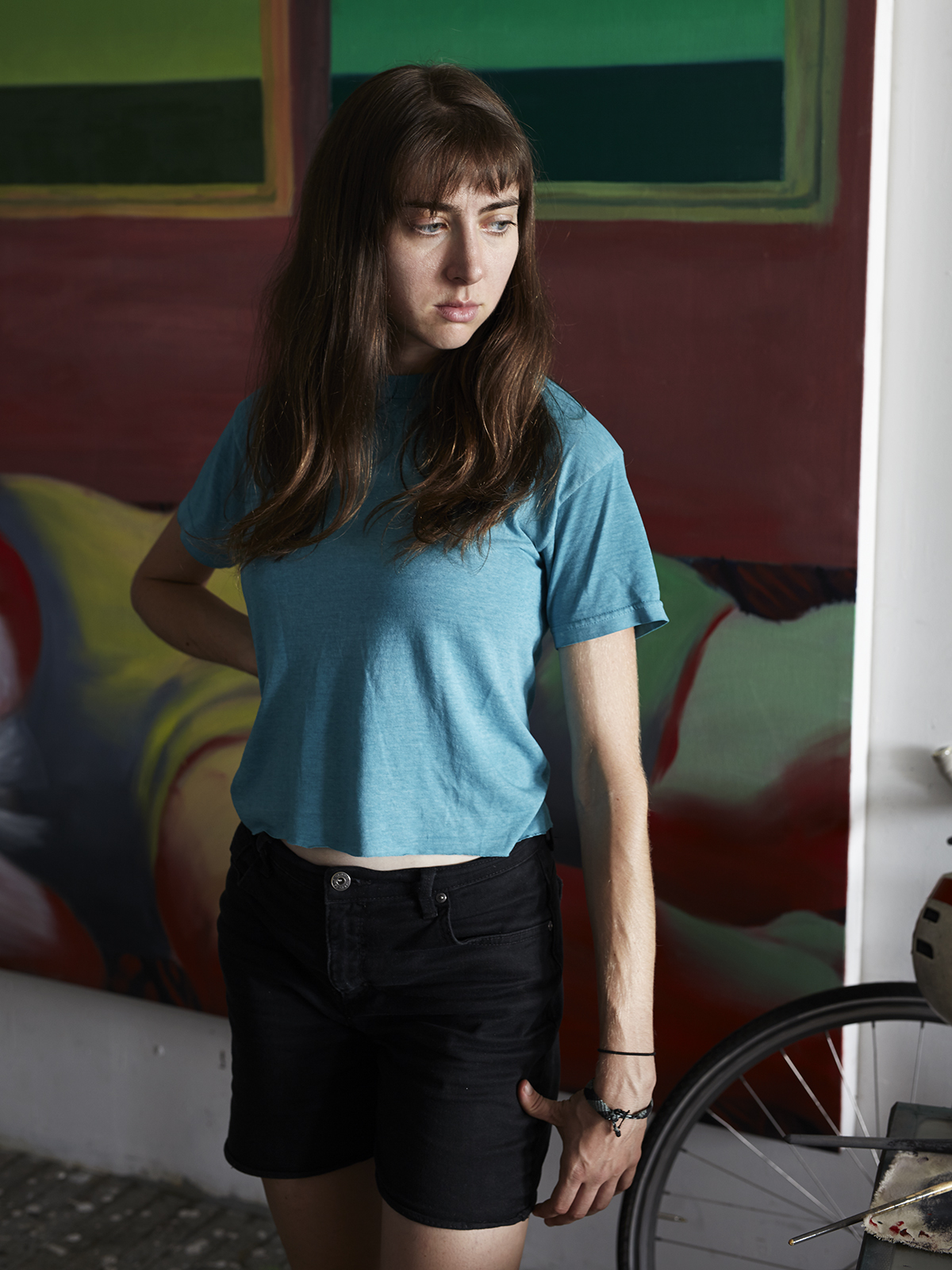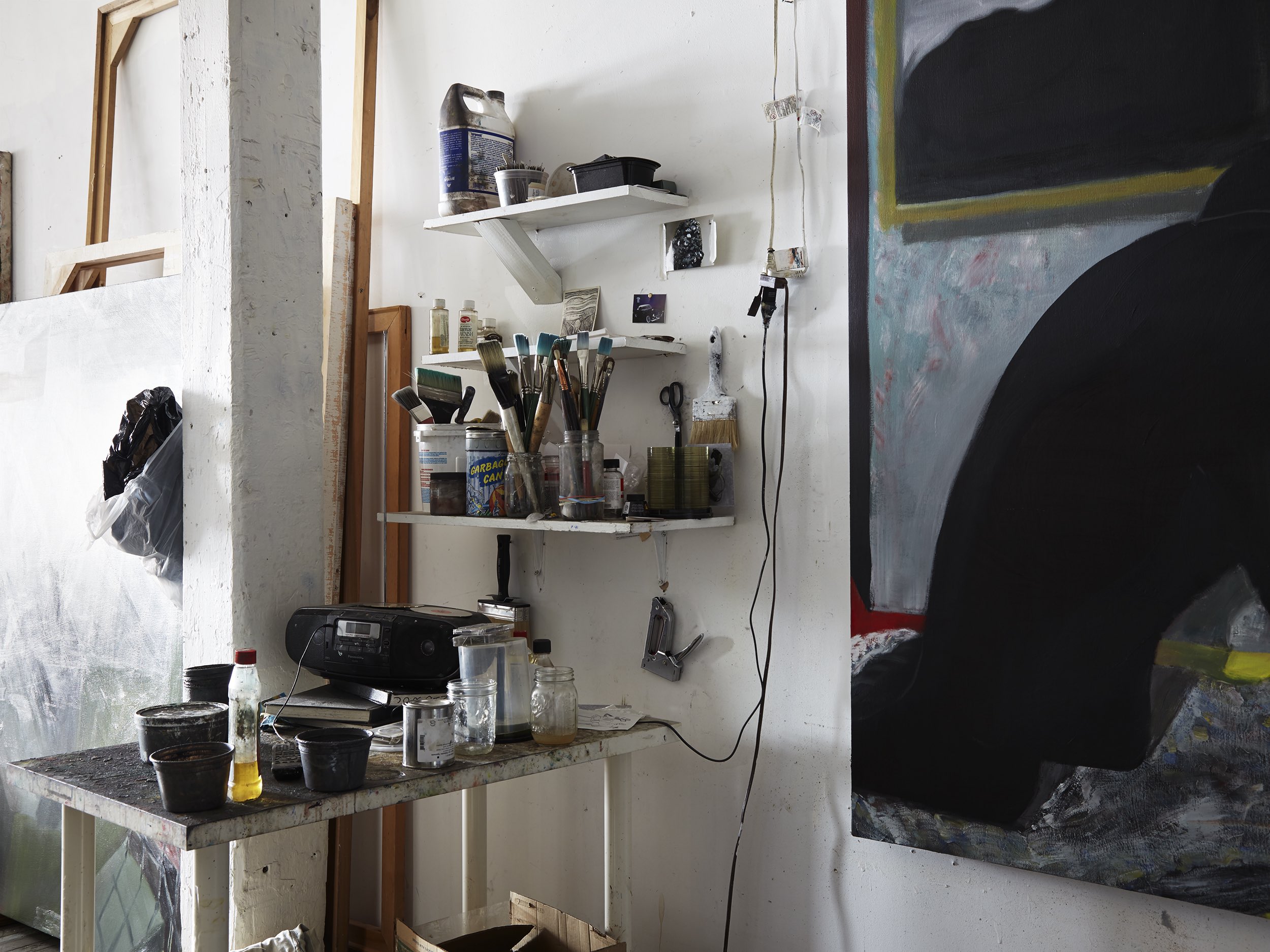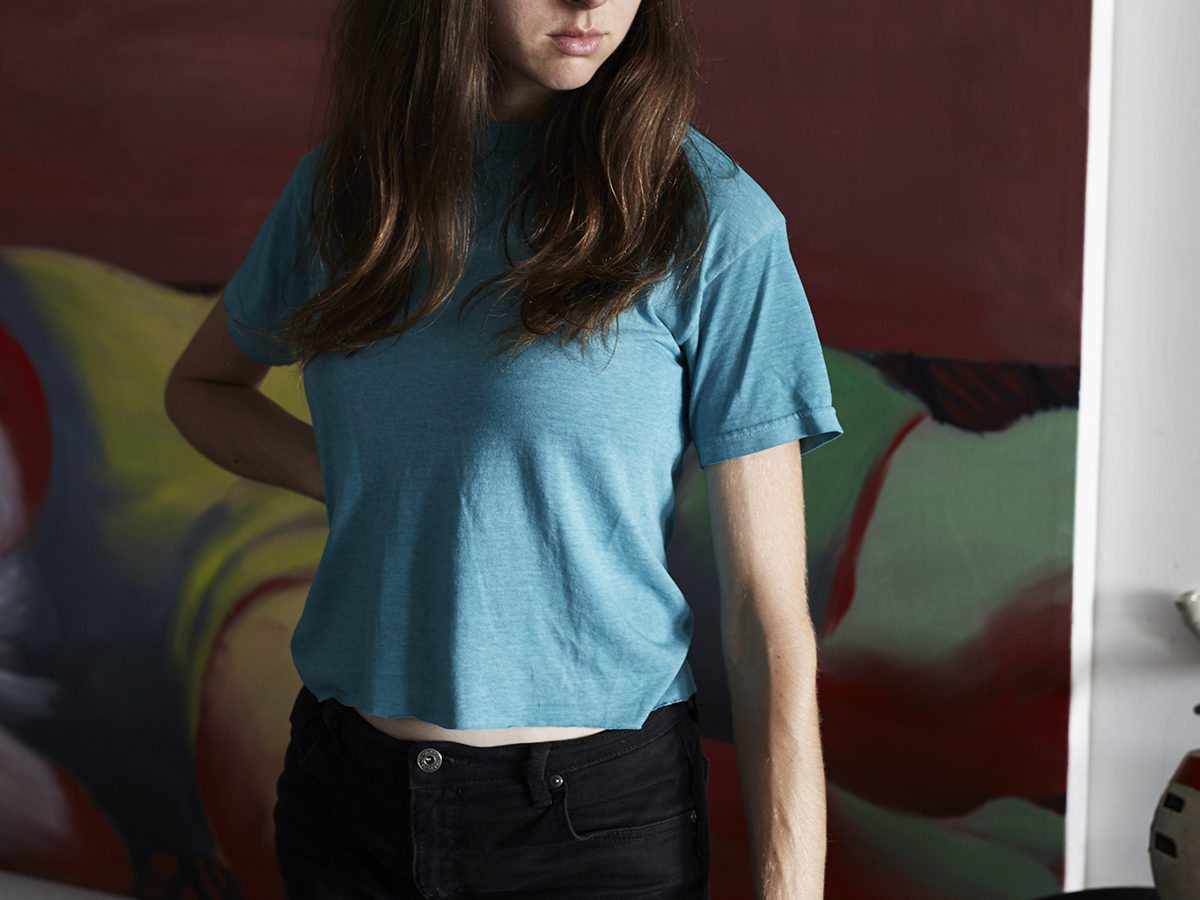 I visited Brooklyn-based painter Jordan Kasey on an unexpectedly blistering autumn day. Naturally there was no air conditioning in Kasey’s Bushwick studio, and the figures in her big, bold canvases seemed to feel the heat just as acutely, their formidable bodies appearing to droop and perspire. As Kasey notes, her figures are “extra-affected by gravity.” Lately her work has been featured in solo exhibitions at Nicelle Beauchene (New York) and Signal Gallery (Brooklyn) and in group shows at MoMA PS1 and White Cube. Until recently, Kasey has avoided any of the markers of identity that would have suggested the people in her paintings inhabit a particular time or place. As a result they seem to exist, sedately, in a timeless present. During my visit we sat on the floor and talk about minerals, travel, and the effect of heat on her work.
I visited Brooklyn-based painter Jordan Kasey on an unexpectedly blistering autumn day. Naturally there was no air conditioning in Kasey’s Bushwick studio, and the figures in her big, bold canvases seemed to feel the heat just as acutely, their formidable bodies appearing to droop and perspire. As Kasey notes, her figures are “extra-affected by gravity.” Lately her work has been featured in solo exhibitions at Nicelle Beauchene (New York) and Signal Gallery (Brooklyn) and in group shows at MoMA PS1 and White Cube. Until recently, Kasey has avoided any of the markers of identity that would have suggested the people in her paintings inhabit a particular time or place. As a result they seem to exist, sedately, in a timeless present. During my visit we sat on the floor and talk about minerals, travel, and the effect of heat on her work.
Before 2016, the bodies in your paintings were fragmented, everything seemed to be falling apart. Yet more recently the figures appear much more complete. Has your approach to painting the body changed?
In earlier work I would avoid making the figure look too human. I also avoided putting in too many contextual clues. I remember feeling really triumphant when I finally put a chair in a painting. Those paintings would just be mostly water, sky, rocks, and blob-like people. I wanted the figures to be anonymous because their gender, race, and even the time period, were all things I didn’t want to pin down. My work isn’t about who the people are, it’s about how it feels to encounter this being, or how it feels to be them.
“…when a doctor visited my studio she said those figures reminded her of a cadaver from medical school.”
In newer work I’ve started to render a greater variety of things and to give the figures more personality, while still keeping them somewhat austere and removed from the viewer. I began to enjoy thinking, “Okay this is a woman and her hair is flying around.” Before I was scared, not only to make the figure a woman, but to paint her hair, because it seemed too difficult. Part of what I’d been avoiding were textures and movements that seemed too technically challenging.
Why were you anxious about painting figures who had an identity?
I think if the figure is too individualized it can make the work seem political or narrative in a way that I want to avoid. I always feel relieved when I make a successfully non-gendered face. Painting people with unrealistic skin tones is kind of a good solution, but when a doctor visited my studio she said those figures reminded her of a cadaver from medical school.
The paintings are about interior states and yet your figures aren’t all that expressive.
I want the emotion to come more from light, colour and what’s happening in the slivers of space that aren’t occupied by the figure. I realized that these reclining figures emerged in the summer, when it was really hot and all I wanted to do was lie on the floor.
There’s a feeling of languid summer heat in so many of your paintings. Was that always the climate in your studio when you painted them?
Yes, for some of them. You can feel the paralyzing heat and the physical challenge of working on a large scale when it’s so hot. But I also just like the figures to have a heaviness to them, like they’re extra affected by gravity. I want them to look permanent, monumental, or sculptural in a way that gives them a feeling of stillness.

You mentioned in an interview that you’ve spent a lot of time sketching minerals and rocks. That’s pretty earthy. Do you use those studies as reference for elements in your big paintings?
What I’ve taken from doing these studies is a way to paint different textures, the way light hits things and thinking about the subtle variations of color within the greys. It’s been helpful by bringing more variation and texture to the paintings. When you’re working from imagination it’s really easy to get caught in certain habits and the results can start to get too stylized, or every surface looks like it is made from the same material.
What inspired you to paint rocks in the first place?
I don’t remember the moment that it came to me. I’ve always liked rocks. When I lived in Baltimore I’d go to the Smithsonian which has a really extensive collection of gems and minerals. Rocks are something I think about especially in relation to the figure, although more so in the past with the blob-like people; an approach I was just starting to leave behind.

What parts of your paintings do you work out in advance and what parts emerge while you’re making them?
I’ll do quick sketches before I start something, but most paintings emerge while I’m making them. I know what the feeling of the painting will be before I have a concrete image.
Do the results ever surprise you?
The painting doesn’t really feel finished until I’ve surprised myself somehow. If I just executed my original idea it ends up looking like an imitation Jordan Kasey painting. Or if I already knew I could do it then I’m bored by it. If I make something that I already knew existed before I started it, why bother finishing? I’ve also been surprised by how badly some of my ideas turn out, but that surprise doesn’t usually take that long. The good surprises happen often enough that I do finish paintings, eventually.
It sounds like being surprised is sort of the point, not just a side-effect of the process.
It’s the best feeling when I’m in awe of a painting as if I didn’t even make it. At a certain point listening to where the painting wants to go becomes more important that putting my own ideas on it.

You just got back from the Cuevas Tilleard artist residency on Lamu Island, Kenya. What was it like to make work outside your studio?
I wanted to take a break from what I usually do and make work under a different set of constraints. I haven’t used charcoal since college, or done a lot of observational work in a long time. During the residency we were living in a crazy giant castle on the water. It was nice just to wander around the house and decide, “I’ll sit here and draw this interesting space for a while and then I’ll move to the weird tower on the roof and draw there.” It felt a little dream-like.
I’ve never done a residency before and I’ve always thought of travel more as a time to take things in than to make stuff. It’s nice to get away the pressure to constantly be productive; to feel out of place or excited; to do something cool or get physically and emotionally exhausted from being in a new environment. Those experiences are productive for my art too because they become part of who I am.
“You can get away with a lot when you’re rendering a figure as long as the hands feel real or the feet feel grounded.”
My eye is always drawn to the hands in your paintings because they’re so expressive.
I’m interested in hands as holding a lot of expression. They’re the one part of the figure, besides feet, that I sketch from my own body. You can get away with a lot when you’re rendering a figure as long as the hands feel real or the feet feel grounded. The hands in the figure I’m painting now are probably going to be wiggly because it’s actually supposed to be a sculpture [of a] person. I’m struggling to figure out how I can paint a sculpture of a person that looks like a sculpture, and not a real person.
How do you do it?
I’m still trying to figure that out. I guess you put them on a little pedestal? That’s one solution.
Photography © Tim Smyth






